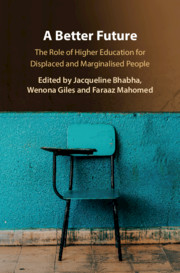Book contents
- A Better Future
- A Better Future
- Copyright page
- Contents
- Figures
- Tables
- Notes on Contributors
- Introduction
- Part I Encountering Marginalisation
- Chapter 1 Disparities in Participation in Higher Education among Migrants
- Chapter 2 Access to Higher Education and Retention of Students with a Migrant Background in the Netherlands
- Chapter 3 Roma in Higher Education
- Chapter 4 Higher Education in Exile
- Chapter 5 Continuing Inequalities in South African Higher Education
- Chapter 6 Inequities in US Higher Education Access and Success
- Chapter 7 Exploring Place
- Part II Deconstructing Marginalisation
- Part III Confronting Marginalisation
- Index
- References
Chapter 7 - Exploring Place
Indigenous Students in US Higher Education
from Part I - Encountering Marginalisation
Published online by Cambridge University Press: 06 September 2020
- A Better Future
- A Better Future
- Copyright page
- Contents
- Figures
- Tables
- Notes on Contributors
- Introduction
- Part I Encountering Marginalisation
- Chapter 1 Disparities in Participation in Higher Education among Migrants
- Chapter 2 Access to Higher Education and Retention of Students with a Migrant Background in the Netherlands
- Chapter 3 Roma in Higher Education
- Chapter 4 Higher Education in Exile
- Chapter 5 Continuing Inequalities in South African Higher Education
- Chapter 6 Inequities in US Higher Education Access and Success
- Chapter 7 Exploring Place
- Part II Deconstructing Marginalisation
- Part III Confronting Marginalisation
- Index
- References
Summary
Indigenous North Americans, particularly those within the historical and current borders of the United States, were (and are) subjected to displacement and marginalisation by pre- and post-colonial government policies and practices. Initially focused on colonial land settlements and Indian removal to land reserves, many of these policies and practices live on through violations of treaties, challenges to sovereignty rights and ongoing existential threats. Today, the starkest visualisation of negative outcomes associated with these policies and practices exists across US systems of public education, especially higher education. Although American Indian college students are finding improved access points to higher education, they remain the least likely of all racial/ethnic groups to experience successful outcomes in secondary and post-secondary settings. Progress in these areas has been too slow and often fraught with tangible and intangible barriers negatively affecting success. This chapter will discuss direct consequences of marginalisation and displacement of Native peoples in the United States; current efforts to improve education outcomes; suggested steps for improving collegiate success for Native students; emerging national higher education initiatives, including those among tribal government education departments; and ethical considerations for collecting, analysing and reporting Native data.
- Type
- Chapter
- Information
- A Better FutureThe Role of Higher Education for Displaced and Marginalised People, pp. 152 - 174Publisher: Cambridge University PressPrint publication year: 2020

